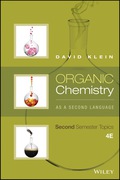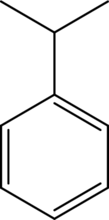
EBK ORGANIC CHEMISTRY AS A SECOND LANGU
4th Edition
ISBN: 9781119234722
Author: Klein
Publisher: JOHN WILEY+SONS,INC.-CONSIGNMENT
expand_more
expand_more
format_list_bulleted
Concept explainers
Question
Chapter 4.7, Problem 4.61P
Interpretation Introduction
Interpretation:
The positions that are prone to electrophilic

Concept Introduction:
Deactivators are electron withdrawing groups attached to the benzenes that have either positive charge or an atom with high electronegativity. They are meta directors.
- Strong deactivators: They are very strong electron withdrawing groups.
- Moderate deactivators: It contains a pi bond that is attached to a strong electronegative group.
- Weak deactivators: It consists of halogens.
Activators are electron donating groups attached to the benzenes that have either electron density that is able to push into benzene ring or a lone pair of electrons. They are ortho-para directing.
- Strong activators: It contains a lone pair next to the aromatic ring.
- Moderate activators: It has a lone pair next to the aromatic ring that can take part in the resonance outside the ring as well.
- Weak activators: It consists of alkyl groups.
Halogens are deactivators that are ortho-para directing.
Expert Solution & Answer
Want to see the full answer?
Check out a sample textbook solution
Students have asked these similar questions
How substituent affects two aspects of electrophilic aromatic substitution ?
Question 15 of 24
Submit
Predict the location where a new substituent will be added when this aromatic
compound undergoes an electrophilic aromatic substitution reaction.
CI-
OCH3
A) I
B)I|
II
TCI
C) II
II
Type here to search
80%
O 54°F
2:12 PM
3/17/2022
PrtSc
Insert
Delete
F5
F6
F8
F9
F10
F11
F12
Which of the following are antiaromatic compounds?
Chapter 4 Solutions
EBK ORGANIC CHEMISTRY AS A SECOND LANGU
Ch. 4.1 - Consider the following reaction, in which an...Ch. 4.1 - Prob. 4.3PCh. 4.1 - Aromatic rings will also undergo iodination when...Ch. 4.2 - In each of the following cases, identify the...Ch. 4.2 - In each of the following cases, identify the...Ch. 4.2 - In each of the following cases, identify the...Ch. 4.3 - Prob. 4.10PCh. 4.3 - Prob. 4.11PCh. 4.3 - Prob. 4.12PCh. 4.3 - Prob. 4.13P
Ch. 4.3 - Prob. 4.14PCh. 4.3 - Predict the products of the following reaction.Ch. 4.3 - Prob. 4.16PCh. 4.3 - Prob. 4.17PCh. 4.4 - Identify the reagents you would use to achieve...Ch. 4.4 - Identify the reagents you would use to achieve...Ch. 4.4 - Identify the reagents you would use to achieve...Ch. 4.4 - Identify the reagents you would use to achieve...Ch. 4.4 - fill in the reagents you would use for the...Ch. 4.4 - fill in the reagents you would use for the...Ch. 4.4 - fill in the reagents you would use for the...Ch. 4.4 - fill in the reagents you would use for the...Ch. 4.4 - Prob. 4.27PCh. 4.4 - Prob. 4.28PCh. 4.4 - And now, for a challenging problem, try to draw...Ch. 4.6 - Prob. 4.31PCh. 4.6 - Prob. 4.32PCh. 4.6 - Prob. 4.33PCh. 4.6 - Prob. 4.34PCh. 4.6 - Prob. 4.35PCh. 4.6 - Prob. 4.36PCh. 4.6 - Prob. 4.37PCh. 4.6 - Prob. 4.40PCh. 4.6 - Prob. 4.41PCh. 4.6 - Predict the products for each of the following...Ch. 4.6 - Predict the products for each of the following...Ch. 4.6 - Predict the products for each of the following...Ch. 4.6 - Predict the products for each of the following...Ch. 4.6 - Prob. 4.47PCh. 4.6 - Prob. 4.48PCh. 4.6 - Prob. 4.49PCh. 4.6 - Prob. 4.50PCh. 4.6 - Prob. 4.51PCh. 4.6 - Prob. 4.52PCh. 4.6 - Prob. 4.53PCh. 4.6 - Prob. 4.54PCh. 4.6 - Prob. 4.55PCh. 4.6 - Prob. 4.56PCh. 4.7 - Prob. 4.58PCh. 4.7 - Prob. 4.59PCh. 4.7 - Prob. 4.60PCh. 4.7 - Prob. 4.61PCh. 4.7 - Prob. 4.62PCh. 4.7 - Prob. 4.63PCh. 4.7 - Prob. 4.64PCh. 4.7 - Prob. 4.65PCh. 4.7 - Prob. 4.66PCh. 4.7 - Prob. 4.67PCh. 4.7 - Can you explain why the following group is a...Ch. 4.7 - Prob. 4.70PCh. 4.7 - Prob. 4.71PCh. 4.7 - Prob. 4.72PCh. 4.7 - Prob. 4.73PCh. 4.7 - Prob. 4.74PCh. 4.7 - Prob. 4.76PCh. 4.7 - Prob. 4.77PCh. 4.7 - Prob. 4.78PCh. 4.7 - Prob. 4.79PCh. 4.8 - Propose an efficient synthesis for each of the...Ch. 4.8 - Propose an efficient synthesis for each of the...Ch. 4.8 - Propose an efficient synthesis for each of the...Ch. 4.8 - Propose an efficient synthesis for each of the...Ch. 4.8 - Propose an efficient synthesis for each of the...Ch. 4.8 - Prob. 4.87PCh. 4.8 - Prob. 4.88PCh. 4.8 - Prob. 4.89PCh. 4.8 - Prob. 4.90PCh. 4.8 - Prob. 4.91PCh. 4.8 - Prob. 4.92PCh. 4.9 - Prob. 4.94PCh. 4.9 - Prob. 4.95PCh. 4.9 - Prob. 4.96PCh. 4.9 - Prob. 4.97PCh. 4.9 - Prob. 4.98PCh. 4.9 - Prob. 4.99PCh. 4.9 - Prob. 4.100PCh. 4.9 - Prob. 4.101PCh. 4.9 - Prob. 4.102P
Knowledge Booster
Learn more about
Need a deep-dive on the concept behind this application? Look no further. Learn more about this topic, chemistry and related others by exploring similar questions and additional content below.Similar questions
- plz asap with detail explanationarrow_forwardCarboxylic acids and its derivatives are reduced by sodium borohydride. True False Less reactive derivatives cannot synthesize more reactive derivatives of RCOOH. True False 1 points 1 points Save Answer Save Answerarrow_forwardHelp me pleasearrow_forward
- C) a nitrile D) an amine nitrite salt DIRECTIONS: Each of the following questions or incomplete statements below is followed by four suggested answers lettered A - D. Select or choose the letters of the best answer to the question or incomplete statement. 7. An organic nitrogen compound, X, gives ammonia on warming with dilute aqueous sodium hydroxide, X could be A) ethanamide B) ethylamine C) phenylamine D) amino ethanoic acid Which one of the following reagents reacts 1. in a similar fashion with both phenylamine (C H,NH,) and ethylamine. A) Br,(aq) C) conc. HNO, D) cold HNO (aq) 2. Phenylamine (aniline) can be prepared by reducing nitrobenzene with tin and concerntrated hydrochloric acid followed by the addition of alkali and finally steam distillation. The alkali is added to; A) prevent oxidation of phenylamine. B) liberate free phenylamine from solution C) dissolve excess nitro benzene D) dissolve the phenylamine 8. Arrange the following molecules in their increasing order of base…arrow_forwardElectrophilic aromatic substitution reactionarrow_forward4arrow_forward
- Draw both resonance structures of the anion formed by the reaction of the most acidic C-H bond of the compound below with base. Include all valence lone pairs in your answer. For structures having different hydrogens of comparable acidity, assume that the reaction occurs at the less-substituted carbon. Draw one structure per sketcher. Add additional sketchers using the drop-down menu in the bottom right corner. Separate resonance structures using the ↔ symbol from the drop-down menu.arrow_forwardDraw both resonance structures of the anion formed by the reaction of the most acidic C-H bond of the compound below with base. Include all valence lone pairs in your answer. For structures having different hydrogens of comparable acidity, assume that the reaction occurs at the less-substituted carbon. Draw one structure per sketcher. Add additional sketchers using the drop-down menu in the bottom right corner. Separate resonance structures using the ↔ symbol from the drop-down menu.arrow_forwardDraw both resonance structures of the anion formed by the reaction of the most acidic C-H bond of the compound below with base. Include all valence lone pairs in your answer. For structures having different hydrogens of comparable acidity, assume that the reaction occurs at the less-substituted carbon. Draw one structure per sketcher. Add additional sketchers using the drop-down menu in the bottom right corner. Separate resonance structures using the ↔ symbol from the drop-down menu.arrow_forward
- predict the product of the following nucleophilic aromatic substitution reactions please help Part C a strong base NaH HO, Draw the molecule on the canvas by choosing buttonsarrow_forwardOWLV2 Test 4 (Modules 13-14) [References] Why are the boiling points of tertiary amines lower than those of corresponding primary and secondary amines? Question 8 1 pt Question 9 1 pt Because primary and secondary amines undergo self- ionization, while tertiary amines do not. Question 10 1 pt Because molecules of primary and secondary amines are polar, while molecules of tertiary amines are nonpolar. Question 11 1 pt Question 12 1 pt Because tertiary amines cannot form hydrogen bonds to each other, while primary and secondary amines Question 13 1 pt can. Question 14 1 pt Because tertiary amines usually have lower molecular weight than primary and secondary amines have. Question 15 1 pt Question 16 1 pt Submit Answer Try Another Version Question 17 1 pt 2 item attempts remainingarrow_forwardOWLV2 Test 4 (Modules 13-14) [References] Question 19 1 pt Disubstituted amides often have lower boiling points than unsubstituted amides. What is the main reason for this Question 20 1 pt observation? Question 21 1 pt Disubstituted amides can form more hydrogen bonds than unsubstituted amides. Question 22 1 pt Disubstituted amides usually have higher molecular Question 23 1 pt weights than unsubstituted amides. Disubstituted amides have less branching than Question 24 1 pt unsubstituted amides. Question 25 1 pt Disubstituted amides have more branching than unsubstituted amides. Question 26 1 pt Disubstituted amides cannot form hydrogen bonds whereas unsubstituted amides can form the hydrogen Question 27 1 pt bonds. Question 28 1 ptarrow_forward
arrow_back_ios
SEE MORE QUESTIONS
arrow_forward_ios
Recommended textbooks for you
 Organic Chemistry: A Guided InquiryChemistryISBN:9780618974122Author:Andrei StraumanisPublisher:Cengage Learning
Organic Chemistry: A Guided InquiryChemistryISBN:9780618974122Author:Andrei StraumanisPublisher:Cengage Learning

Organic Chemistry: A Guided Inquiry
Chemistry
ISBN:9780618974122
Author:Andrei Straumanis
Publisher:Cengage Learning